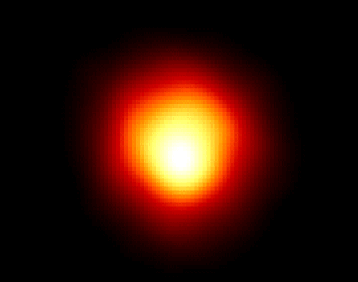Astronomy Picture of the Day
Discover the cosmos! Each day we feature a different image or photograph
of our fascinating universe, along with a brief explanation written by a
professional astronomer.
January 22, 1996

Betelgeuse, Betelgeuse, Betelgeuse
Credit:
A. Dupree (CfA),
R. Gilliland (STScI),
NASA,
ESA
Explanation:
Betelgeuse
(sounds a lot like "beetle juice"),
a red supergiant star about 600 lightyears distant, is shown here in this
Hubble Space Telescope
image
which represents the first direct
picture of the surface of a star other than the Sun.
While
Betelgeuse
is cooler than the Sun, it is more massive and over
1000 times larger - if placed at the center of
our Solar System,
it would extend past the orbit of Jupiter.
This image reveals a bright, as yet unexplained hotspot on its surface.
Betelgeuse
is also known as Alpha Orionis, one of the
brightest stars
in the
familar constellation of
Orion, the Hunter.
Like many
star names,
Betelgeuse is
Arabic in origin. It is derived from a phrase which
refers to the hunter's shoulder
or armpit, the general area occupied by this star in drawings of the
figure in the
constellation.
As a massive red supergiant, it is
nearing the end of its life and will soon become a
supernova.
Tomorrow's picture: Beneath Jupiter's Clouds
| Archive
| Index
| Glossary
| Education
| About APOD |



Authors & editors:
Robert Nemiroff
(GMU) &
Jerry
Bonnell (USRA).
NASA Technical Rep.:
Sherri
Calvo.
Specific rights apply.
A service of:
LHEA
at
NASA/
GSFC



